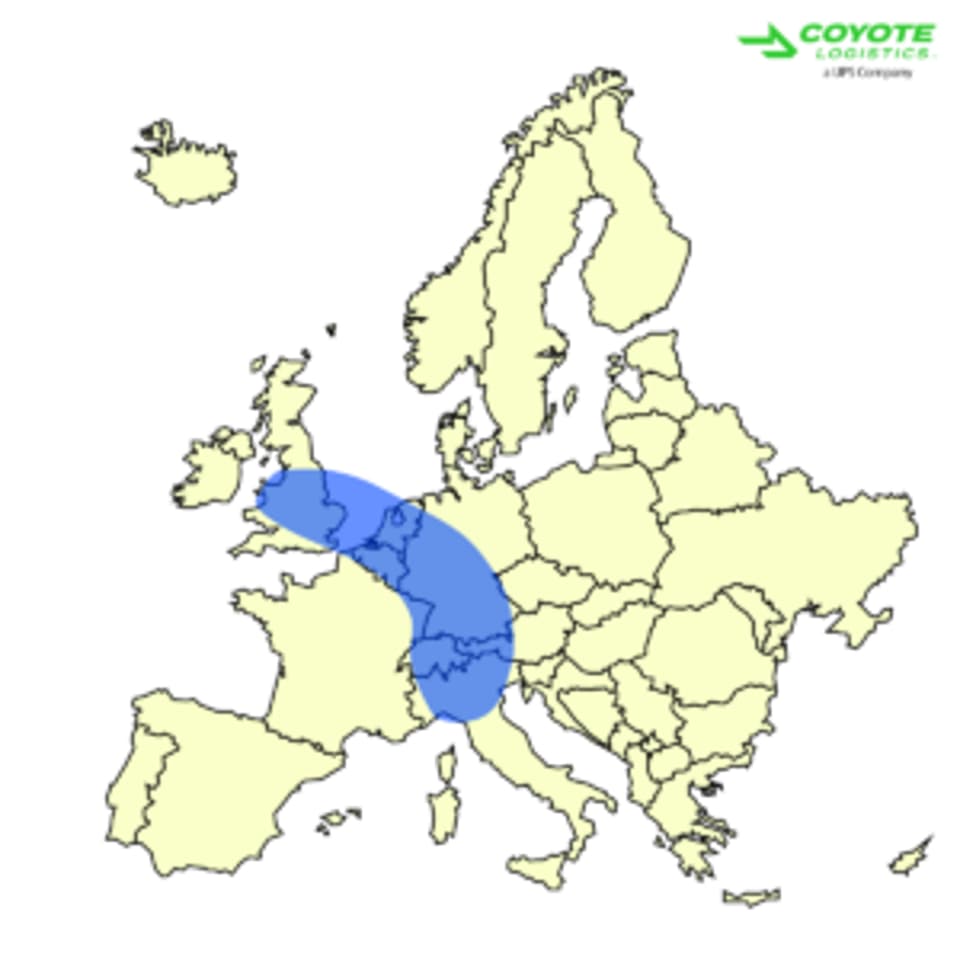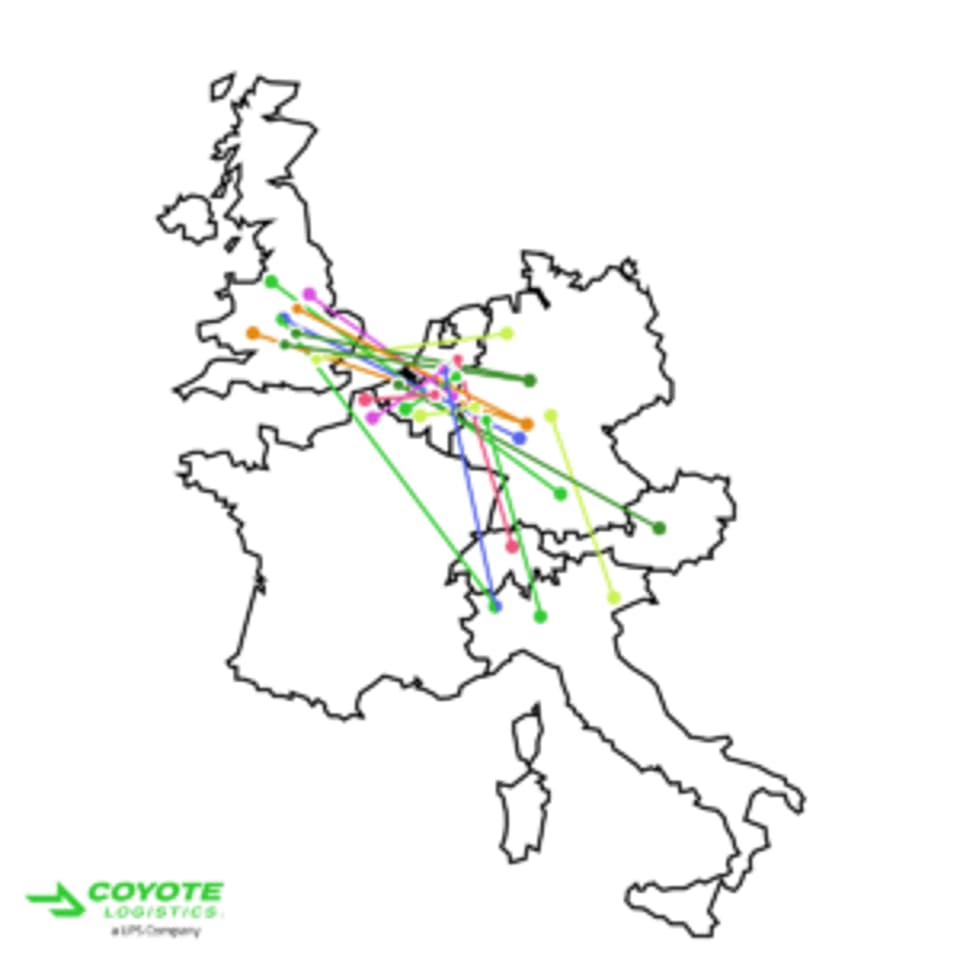The Blue Banana, or What Is a European Banana?

Have you ever heard of Blue Banana? Sounds a bit enigmatic, right? Is it the prop used in the performances of the legendary artists of the Blue Man Group? Or maybe we are talking about an existing blue fruit? None of these things. The blue banana, also known as the European banana, has nothing to do with performing arts and fruits. But a lot with industry and transport in Europe. Intrigued? Let us explain.
Blue banana: where does this term come from?
The world first heard about the Blue Banana in 1989, when the phrase was used by scientists from the RECLUS group (French: Réseau d’étude des changements dans les localizations et les unités spatiales), headed by the French geographer Roger Brunet. The name Blue Banana is sometimes used interchangeably with terms such as the already mentioned European banana, European megalopolis and the Liverpool-Milan axis.
European banana: what is it?
The term European banana is used to describe the area of western and central Europe, which stretches from north-west England to northern Italy. It covers countries, regions and lands such as: Greater London (England), Lille European Metropolis, Alsace and Moselle (France), Benelux, Westphalia, Rhineland and Bavaria (Germany), Austria, Switzerland and Lombardy (Italy). It is inhabited by about 100 million people.

Scientists from the RECLUS group set the conventional boundaries of the European banana, guided by the areas with the highest level of urbanization and population density in Western and Central Europe, but they also took into account the common features of this area: temperate climate, fertile soils in lowland areas and mineral resources found in upland areas and mountains. The demarcated territory took the shape of a gentle arc, the curved ends of which are found in North West England and Lombardy. The resemblance to a banana suggests itself. Where does the blue color in the name come from? Two explanations can be found: it was supposed to be a reference to the color of the flag of the European Union (then still the European Community) or to the term “blue collars”meaning industrial workers.
Within Blue Banana there are cities that are European economic and development centers (London, Amsterdam, Brussels, Frankfurt am Main, Zurich and Milan). Why is it important? Because it is the fact that industrial and university centers are grouped in such a large number in this area that distinguishes this part of Western Europe from the rest of the continent. The environmental conditions in the area of the European banana are not so exceptional compared to other areas in the temperate zone. However, it is precisely the fact that over the centuries trade routes ran here, large urban centers were created here (which meant that the population density in Blue Banana currently reaches 400 people per square km), and with them scientific and manufacturing centers as well, prompted researchers to demarcate the area of Blue Banana. It is safe to say that the Liverpool-Milan axis is a kind of European backbone when it comes to the development of economy and science.
It is worth noting that the original concept of Blue Banana does not include Paris and its surroundings, although the latest studies already include the French capital in this area. Presenting the idea of the European banana, the team led by Roger Brunet explained that the exclusion of Paris from this area is historically motivated: the model assumed economic integration of these areas over the centuries, while –according to researchers –France lost its connection with them until the 17th century and developed more separately.
In the early 1990s, there were voices criticizing Blue Banana as more of an ideal model than a reflection of reality. Competing concepts were also presented. One of them –the House with Seven Apartments –assumed the division of Europe into seven geographical areas, separated on the basis of their economic dynamics. In turn, in the model called the Bunch of Green Grapes, the whole of Western and Southern Europe was divided into many (smaller or larger) urbanized areas, which were to create an extensive network facilitating further development of the European continent.
Today, the European economy looks different than in 1990, when Roger Brunet and his team first set the boundaries of Blue Banana. Services and innovations sectors are now the main drivers of the European economy, not industry and finance sectors. Thus the importance of Blue Banana is smaller, but it is still an important economic center of the Old Continent. Just look at road transport.
A key European logistics ax
Despite economic and political changes in Europe, Blue Banana –due to the extensive infrastructure of roads and highways –still remains a key logistics corridor in Europe. In the last 25 years, however, Blue Banana has been supplemented by nine strategic transport axes that together form the TEN-T, i.e. the Trans-European Transport Network.
Four years ago, analysts from the consulting company Cushman &Wakefield published a report entitled “The Changing Face of Distribution: The Shape of Things to Come”, in which they forecast the development of current and the emergence of new logistics corridors in Europe by 2030. They took into account both economic factors (e.g. an increase in the number of transports with increasing transport costs, development of innovative technologies) and political (effects of Brexit). According to the predictions in the report, by 2030 the Blue Banana will be joined by further corridors: British, Irish, Iberian, Central European, North Sea, Black Sea and Baltic Sea. And the growing importance of transport across the Mediterranean Sea will mean that Blue Banana will be extended all the way to Genoa in Italy.
Blue Banana, despite the changes of recent decades, still remains a key area for transport and logistics in Europe. Just look at the map below to see how many lanes in this area are being covered by Coyote Logistics every day.

P.S. Blue bananas actually do exist. The Blue Java variety is distinguished by a consistency comparable to ice cream and a taste reminiscent of vanilla. It’s just that blue is only in the name, because the peel and the fruit itself are yellow.
You are looking for an experienced and reliable logistics partner who will move your loads on lanes within Blue Banana?
Among others, the following sources were used:
- https://en.wikipedia.org/wiki/Blue_Banana
- https://www.usc.es/economet/reviews/eers1312.pdf
- https://issuu.com/cushwake_be/docs/report_-_changing_face_of_distribut